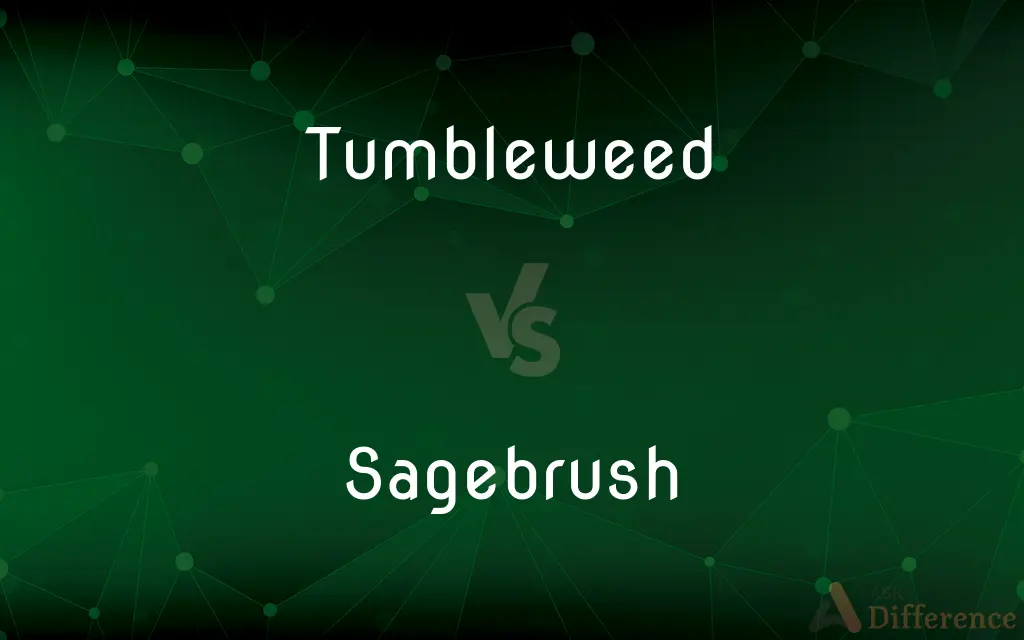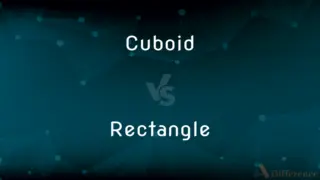Tumbleweed vs. Sagebrush — What's the Difference?
Edited by Tayyaba Rehman — By Maham Liaqat — Updated on March 19, 2024
Tumbleweed typically refers to plants that break away and roll with the wind for seed dispersal, while sagebrush is a perennial, woody shrub known for its aromatic leaves, part of the artemisia family and common in arid regions of North America.

Difference Between Tumbleweed and Sagebrush
Table of Contents
ADVERTISEMENT
Key Differences
Tumbleweeds are not a single species of plant but rather a descriptive term for any plant that adopts a rolling dispersal mechanism. After maturing and drying out, these plants detach from their root system and tumble with the wind, spreading their seeds over a wide area. In contrast, sagebrush, specifically known as Artemisia tridentata, is a dominant plant in the Great Basin and other North American deserts, characterized by its hardy nature and the strong, distinctive aroma released by its leaves, especially when crushed or during rainfall.
The life cycle of tumbleweeds involves growing, maturing, and then breaking off at the stem to disperse seeds, which contrasts with the perennial nature of sagebrush, which remains rooted and can live for many years, growing larger over time. Tumbleweeds are often associated with desolate or neglected areas, as their rolling nature allows them to thrive in disturbed soils, whereas sagebrush is a key component of the sagebrush steppe ecosystem, providing habitat and food for a variety of wildlife.
Tumbleweeds can include several plant species, such as those from the genus Salsola or Russian thistle, which were introduced to new environments and became synonymous with the tumbleweed image. Sagebrush, on the other hand, is native to North America and is recognized for its ecological importance, especially in supporting wildlife such as the greater sage-grouse.
The physical appearance of tumbleweeds is typically spherical and bushy when they begin their tumbling phase, designed to maximize wind catchment and seed dispersal efficiency. Sagebrush has a more traditional shrub-like appearance, with a woody structure, and can grow quite large, with some species reaching up to 2 meters in height. Its leaves are small, narrow, and often covered with fine hairs, adapted to minimize water loss.
In terms of human interaction, tumbleweeds are often considered a nuisance, especially when they accumulate against fences and houses or invade agricultural fields. Sagebrush, while valuable to its ecosystem, can also pose challenges to farmers and ranchers, as it competes with grasses for resources in rangelands, yet it is also recognized for its essential role in the biodiversity of arid landscapes.
ADVERTISEMENT
Comparison Chart
Definition
Plants that break off and roll to disperse seeds.
A perennial, woody shrub known for its aromatic leaves.
Habitat
Arid and semiarid regions, disturbed soils.
Great Basin and arid regions of North America.
Dispersal
Wind-driven rolling.
Does not move; seeds dispersed by wind.
Lifespan
Completes life cycle in one season.
Perennial, can live for many years.
Ecological Role
Pioneer species, colonizes disturbed areas.
Dominant in sagebrush steppe, supports diverse wildlife.
Physical Appearance
Spherical, bushy when rolling; varies when rooted.
Woody, with small, narrow leaves; can grow up to 2 meters.
Human Interaction
Often considered a nuisance.
Valued for ecological importance but can compete with grasses in rangelands.
Compare with Definitions
Tumbleweed
A plant that tumbles with the wind to spread seeds.
The tumbleweed rolled across the deserted landscape, scattering seeds as it went.
Sagebrush
Dominant plant in North American deserts.
Sagebrush covers vast areas of the Great Basin, shaping the landscape.
Tumbleweed
Associated with the American West in popular culture.
Tumbleweeds are often featured in Western films to emphasize the desolate setting.
Sagebrush
A perennial shrub with aromatic leaves.
The sagebrush emitted a pungent aroma after the rain.
Tumbleweed
Often invasive species.
Russian thistle, a common tumbleweed, was inadvertently introduced and has since spread widely.
Sagebrush
Provides habitat for wildlife.
The sagebrush steppe is critical habitat for the greater sage-grouse.
Tumbleweed
Adapted for wind dispersal.
The tumbleweed's spherical shape is perfect for being carried by the wind.
Sagebrush
Important in indigenous cultures and herbal medicine.
Native American tribes have used sagebrush for various medicinal purposes.
Tumbleweed
Symbolic of desolate or neglected areas.
Tumbleweeds cluttering the yard gave the abandoned house an eerie feeling.
Sagebrush
Characterized by woody growth and small leaves.
Sagebrush's small, hairy leaves are adapted to conserve water.
Tumbleweed
A tumbleweed is a structural part of the above-ground anatomy of a number of species of plants. It is a diaspore that once it is mature and dry, detaches from its root or stem and rolls due to the force of the wind.
Sagebrush
Sagebrush is the common name of several woody and herbaceous species of plants in the genus Artemisia. The best known sagebrush is the shrub Artemisia tridentata.
Tumbleweed
Any of various densely branched annual plants, such as Russian thistle and several species of amaranth, that break off from the roots at the end of the growing season and are rolled about by the wind.
Sagebrush
Any of several aromatic plants of the genus Artemisia of the composite family, especially A. tridentata, a shrub of arid regions of western North America, having silver-green leaves and large clusters of small white flower heads.
Tumbleweed
Any plant which habitually breaks away from its roots once dry, forming a light, rolling mass which is driven by the wind from place to place; as Russian thistle, wild indigo, witch grass, Amaranthus albus, etc.
Sagebrush
An area dominated by sagebrush.
Tumbleweed
(attributive) Describing unwanted silence and inactivity. Often used of a situation when one makes a statement that is ignored or ill-received by one's audience, as the resultant silence is likened to that of a desolate desert with rolling tumbleweeds.
Sagebrush
Any of several North American aromatic shrubs of the genus Artemisia, having silvery-grey, green leaves.
Tumbleweed
A tan colour, like that of a tumbleweed.
Sagebrush
A low irregular shrub (Artemisia tridentata), of the order Compositæ, covering vast tracts of the dry alkaline regions of the American plains; - called also sagebush, and wild sage.
Tumbleweed
Any plant which habitually breaks away from its roots in the autumn, and is driven by the wind, as a light, rolling mass, over the fields and prairies; such as witch grass, wild indigo, Amarantus albus, etc.
Sagebrush
Any of several North American composite subshrubs of the genera Artemis or Seriphidium
Tumbleweed
Any plant that breaks away from its roots in autumn and is driven by the wind as a light rolling mass
Tumbleweed
Prickly bushy Eurasian plant; a troublesome weed in central and western United States
Tumbleweed
Bushy annual weed of central North America having greenish flowers and winged seeds
Tumbleweed
Bushy plant of western United States
Common Curiosities
Why is sagebrush important to ecosystems?
Sagebrush is crucial for its ecosystem, providing habitat and food for numerous species and contributing to the biodiversity of arid regions.
Can tumbleweed be any type of plant?
Tumbleweed refers to plants that adopt a tumbling mechanism for seed dispersal, not a specific species, so several plant types can be considered tumbleweeds.
What is the main difference between tumbleweed and sagebrush?
The main difference is that tumbleweed refers to plants that break off and roll with the wind to disperse seeds, while sagebrush is a perennial, stationary shrub known for its aromatic leaves and resilience in arid environments.
Is sagebrush only found in North America?
While sagebrush is native to North America and particularly symbolic of the Great Basin region, similar species or related plants may be found in other arid regions worldwide.
Are all tumbleweeds the same species of plant?
No, the term "tumbleweed" refers to a growth habit rather than a specific species; several plant species can become tumbleweeds, the most famous being the Russian thistle.
How can sagebrush be identified?
Sagebrush can be identified by its woody structure, small, narrow leaves, and the distinctive, aromatic scent of its leaves, especially when crushed.
Can sagebrush be used for anything?
Sagebrush has uses in herbal medicine, and its wood can be used for fuel. It also plays a role in cultural practices among indigenous peoples.
What challenges do tumbleweeds pose?
Tumbleweeds can accumulate against structures, invade fields, and pose fire hazards, making them a nuisance in affected areas.
Do tumbleweeds have roots?
Tumbleweeds start with roots when they grow, but they detach from their root system to tumble and disperse seeds when mature.
Can tumbleweeds cause any problems?
Yes, tumbleweeds can cause problems by piling up against fences and structures, obstructing roads and pathways, and being a fire hazard due to their dry nature.
How do tumbleweeds disperse their seeds?
Tumbleweeds disperse seeds by breaking off from their roots and tumbling with the wind, which spreads the seeds over a wide area as the plant moves.
Why is sagebrush important to its ecosystem?
Sagebrush is crucial to its ecosystem, providing habitat and food for a variety of wildlife, including birds and small mammals, and playing a significant role in soil stabilization and water retention.
How do tumbleweeds reproduce?
Tumbleweeds reproduce by producing seeds that are dispersed as the dried plant breaks off from its root and tumbles with the wind, spreading the seeds over a wide area.
Are there any efforts to control tumbleweed populations?
Efforts to control tumbleweed populations include mechanical removal, herbicide application, and biological control methods, but complete eradication is challenging due to their efficient dispersal mechanism.
How do sagebrush and tumbleweeds adapt to arid environments?
Both plants have adaptations to survive arid conditions; sagebrush has deep root systems and small, aromatic leaves to reduce water loss, while tumbleweeds produce numerous seeds that can lie dormant until conditions are favorable.
Is sagebrush edible or used in any traditional remedies?
Sagebrush has been used in traditional medicine by indigenous peoples for various ailments, and some species can be used as a culinary herb, although it is not widely consumed due to its strong flavor and potential toxicity in large amounts.
Can tumbleweeds be found in the same habitats as sagebrush?
Yes, tumbleweeds and sagebrush can often be found in similar arid and semi-arid environments, such as deserts and plains, though tumbleweeds tend to invade disturbed soils more frequently.
Share Your Discovery

Previous Comparison
Cuboid vs. Rectangle
Next Comparison
Create vs. CurateAuthor Spotlight
Written by
Maham LiaqatEdited by
Tayyaba RehmanTayyaba Rehman is a distinguished writer, currently serving as a primary contributor to askdifference.com. As a researcher in semantics and etymology, Tayyaba's passion for the complexity of languages and their distinctions has found a perfect home on the platform. Tayyaba delves into the intricacies of language, distinguishing between commonly confused words and phrases, thereby providing clarity for readers worldwide.















































